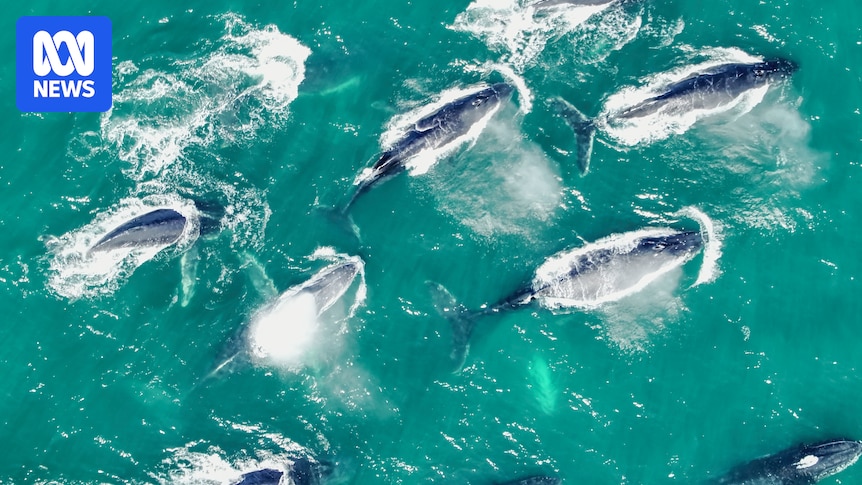A Port Macquarie photographer says capturing vision of a tightly packed pod of 11 whales off the NSW mid-north coast was “something special”.
Drone operator Alex McNaught was tipped off by veteran whale spotter Leigh Mansfield on Monday.
He launched a drone off Rocky Beach and then Tacking Point, filming a large whale pod heading south at speed in a tight formation.
A heat run of male humpbacks crests for a quick breath in the race to a female on heat. (Supplied: Alex McNaught)
“My guess would be in something like a mating pursuit, [as] that’s when you see a group of males put on a burst of speed,” Mr McNaught said.
“You could see them churning the water, there were many puffs, as they were breathing hard and moving fast.
Alex McNaught flies his camera drones up to a kilometre above migrating whales. (Supplied: Alex McNaught)
“I had a difficult time counting them at first, because my [drone camera] screen was absolutely full of whales.”
For the past 20 years, Mr Mansfield has worked as a whale spotter with a local cruise company and volunteered for ORRCA, the Organisation for the Rescue and Research of Cetaceans in Australia.
He has witnessed the contest for a mating opportunity at the end of a pursuit, known as a “heat run”.
Leigh Mansfield estimates he spots 15,000 whales each season. (ABC Mid North Coast: Emma Siossian)
“Generally you will get these pods of between five and 10 males, because they can sense a female on heat and they will try to get to that female as quick as they can,” Mr Mansfield said.
“The males actually fight each other and they could kill each other, that’s how hard they hit each other with their tails and their bodies.”
October is a peak month on the NSW mid-north coast to view the humpbacks’ southern migration to the krill fields of Antarctica.
A large pod of male humpbacks speeds after a female on heat. (Supplied: Alex McNaught)
“You actually need to look from the shoreline out, as you can have whales swimming 50 metres past you at this time of year, in just 5 metres of water,” Mr Mansfield said.
He said mothers shepherded their calves through shallower waters to avoid predators.
“Killer whales do come up the coast to Queensland,” Mr Mansfield said.
“We did sight three [killer whale] pods going north this year because they love [eating] the tongue on these newborn babies.”
University of Queensland associate professor in animal behaviour Rebecca Dunlop has seen pursuit pods grow in number during her 20 years researching the humpbacks’ southern migration.
Rebecca Dunlop listens to whale song. (Supplied: Rebecca Dunlop)
“When I first started working, you would see the odd competitive groups going through,” Associate Professor Dunlop said.
“But even that would be only four or five animals at maximum and you would see them, if you were lucky, only once per season.
“Now we’ve got so many whales migrating, they are forming these big pods of upwards of 10 animals … a lot more common than even a few years ago,” she said.
Associate Professor Dunlop said forming competitive groups was typical whale behaviour when a female was in oestrus or ready to mate.
“Where you get a number of whales chasing a female with her calf, it is dangerous for the calf, so she [the mother] will try and avoid these interactions where she can,” she said.
“She’ll swim with him [the calf] and breathe when he breathes and she will keep him very close, but he can get caught up in it sometimes, so it is actually dangerous for the calf.”
The trigger for the pursuit is still not known.
“If she is in oestrus, I think she just makes certain sounds and that’s probably what is attracting them in.”
Large competitive pods of humpback whales pursuing a female are now more common. (Supplied: Alex McNaught)

